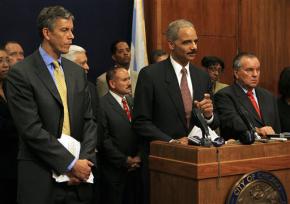A truly Nobel-worthy effort
Seattle teacher has some suggestions for the Obama administration in its search for an end to youth violence.
PRESIDENT BARACK Obama launched a new national initiative against youth violence in the wake of the brutal killing of Derrion Albert, a 16-year-old sophomore at Chicago's Fenger Academy High.
Derrion's fatal beating by several other teens, captured on video from an onlooker's cell phone, has inundated the nightly news and the blogosphere--prompting U.S. Education Secretary Arne Duncan, the former chief of the Chicago Public Schools, to visit Chicago October 7 to address the issue of youth violence.
But to many parents, students and teachers in Chicago, Duncan's visit represented the perpetrator returning to scene of the crime.
That's because the "Renaissance 2010" initiative that Duncan helped launch in 2005 ordered dozens of Chicago's public schools closed and thousands of students reassigned to campuses outside their neighborhoods--and often across gang lines.
The closure of these public schools was a move by Duncan to bring in privatized charter schools that take public funds and place them in schools outside of public oversight. In numerous school board meetings and protests, community members warned Duncan that the reckless closing of schools would have dire consequences--from the loss of cherished education programs and neighborhood schools, to the increase in gang violence.

Before the 2006 school year, an average of 10 to 15 public school students were fatally shot each year. But, as schools were shut down and public education was eroded, deadly shootings soared: 24 in the 2006-07 school year, 23 in the 2007-08 school year, and last year ended with a record 34 deaths and 290 shootings.
"You have a trail of blood and tears ever since they launched [Renaissance 2010]," Tio Hardiman, director of the anti-violence organization CeaseFire Illinois, told the Associated Press. "There's a history of violence associated with moving kids from one area to another."
Investing in our public schools and after-school programs (rather than siphoning off money from them in the form of charter schools) and investing in job programs and universal health care (rather than investing in failed banks) could take our nation a long way toward alleviating the conditions of hopelessness that breed violence.
But even reprioritizing spending on social services and education isn't enough to save youth from violence when America is fighting two wars in the Middle East--wars Duncan has helped to fuel through his unyielding support for military recruitment in the schools. As Mother Jones reported,
In one area...Chicago's schools stood out: In large part to Duncan's efforts, they were--and remain--the most militarized in America. Nearly 10,500 of Chicago's 203,000 sixth- through twelfth-graders participate in some kind of military program on campus...Duncan oversaw the controversial move to bring full-fledged military academies to the Windy City.
Inauspiciously, the Obama administration chose October 7 to issue its press release calling for a "National conversation on values to address youth violence." October 7 marked the eighth anniversary of the war in Afghanistan--a war that has enlisted tens of thousands of America's youth to carry automatic weapons to a foreign land to participate in the unhinged brutality of an occupation.
As Obama considers whether to bow to the generals and send an additional 40,000 troops to Afghanistan--a war widely becoming known as "Obama's Vietnam"--already some 800 Americans and thousands more Afghans have been killed in this conflict.
If Obama wants his national conversation on youth violence to be more than platitudes and hype, he would do well to revisit these words delivered by fellow Nobel Peace Prize winner Martin Luther King Jr. in his famous "Beyond Vietnam" speech:
We were taking the black young men who had been crippled by our society and sending them 8,000 miles away to guarantee liberties in Southeast Asia which they had not found in southwest Georgia and East Harlem. So we have been repeatedly faced with the cruel irony of watching Negro and white boys on TV screens as they kill and die together for a nation that has been unable to seat them together in the same schools. So we watch them in brutal solidarity burning the huts of a poor village, but we realize that they would hardly live on the same block in Chicago...
I knew that I could never again raise my voice against the violence of the oppressed in the ghettos without having first spoken clearly to the greatest purveyor of violence in the world today: my own government.


